Summary
- Lesson for All Political Parties: The Democratic Party’s leadership crisis highlights the necessity of generational change and staying connected with party members, activists, and the public to remain relevant and effective. Failure to adapt to shifting voter expectations can lead to declining support and internal turmoil.
- Strategic Divisions: Senate Minority Leader Chuck Schumer’s decision to support a Republican-led funding bill exposed deep divisions within the Democratic Party. While Schumer framed it as a necessary compromise, many Democrats saw it as capitulation, fuelling accusations of weak opposition to Trump.
- Declining Favourability: Democratic Party approval ratings have reached historic lows, with many voters feeling that their leaders are not fighting hard enough against the Republican agenda. Internal dissatisfaction has led to growing support for primary challenges and calls for Schumer’s resignation.
- Leadership Vacuum: Despite widespread frustration, there is no clear consensus on who should replace Schumer, as much of the party’s leadership consists of long-time figures considered too cautious. This uncertainty complicates the party’s ability to present a unified and effective opposition to the Trump-led Republican Party.
- Future Implications: The Democratic Party risks further alienating its base and losing electoral momentum if it fails to resolve its internal conflicts. The 2026 midterms will test whether the party can unify under new leadership or remain fragmented, potentially giving Republicans an advantage.
Details
Political parties must continually evolve to remain effective, and the Democratic Party’s current leadership crisis offers a critical lesson for all political movements: the necessity of generational change and maintaining a strong connection with party members, activists, and the broader public. As voter expectations shift, party leaders who fail to adapt risk alienating their base and losing their political momentum. The Democratic Party’s struggle to balance its traditional leadership with the demands of an increasingly assertive voter base underscores the importance of staying responsive to those who fuel electoral success.
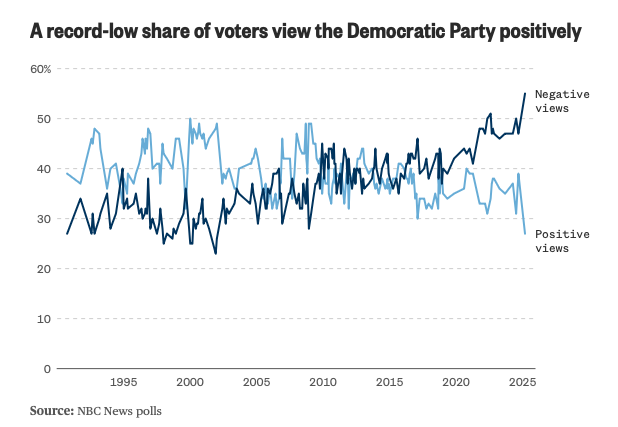
The Democratic Party’s Leadership Crisis
The Democratic Party is facing a profound leadership crisis, exacerbated by deep internal divisions and a growing dissatisfaction among its voter base. The recent controversy surrounding Senate Minority Leader Chuck Schumer’s decision to support a Republican-led government funding bill has intensified long-standing tensions within the party. This episode has not only exposed strategic disagreements over how best to counter the Trump administration but has also sparked calls for a leadership overhaul.
At the heart of the crisis is a fundamental disagreement over how the Democratic Party should approach governing in an era dominated by former President Donald Trump. Schumer’s rationale for supporting the funding bill was pragmatic—he argued that preventing a government shutdown would minimise the power of Trump and Elon Musk’s Department of Government Efficiency (DOGE). However, his decision has been met with widespread backlash from within his party.
House Democrats, particularly those on the progressive wing, have expressed a sense of betrayal, arguing that Schumer’s concession amounted to a capitulation to Republican priorities. Representative Alexandria Ocasio-Cortez voiced her frustration, stating that the funding bill “codifies the chaos and reckless cuts that Elon Musk has been pursuing.” Meanwhile, House Minority Leader Hakeem Jeffries and Speaker Emerita Nancy Pelosi have criticised Schumer’s framing of the issue, insisting that Democrats should have pushed for a stronger negotiating position rather than accepting a “false choice.”
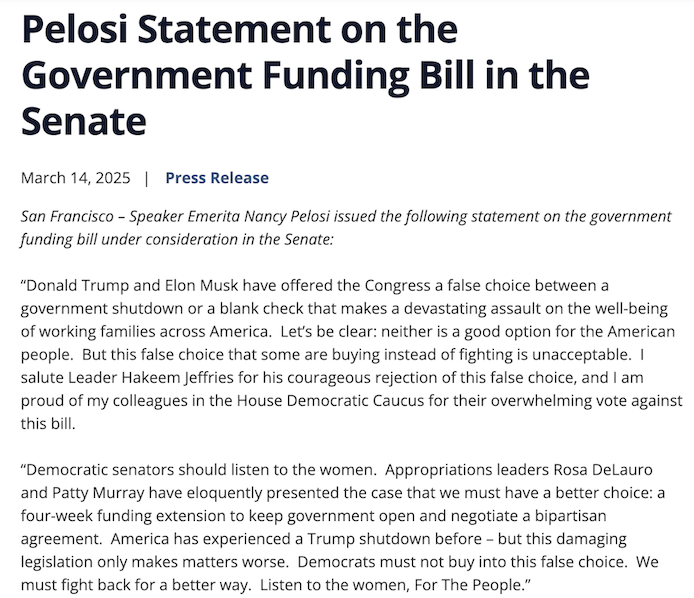
This discord reflects a larger trend: Democratic voters increasingly favour aggressive opposition to Trump over bipartisan compromise. Recent polling shows that a significant majority of Democrats now want their leaders to focus primarily on stopping the Republican agenda, even at the cost of political gridlock. This shift has led to mounting pressure on the Democratic leadership to adopt a more combative stance—something many believe Schumer failed to do in this instance.
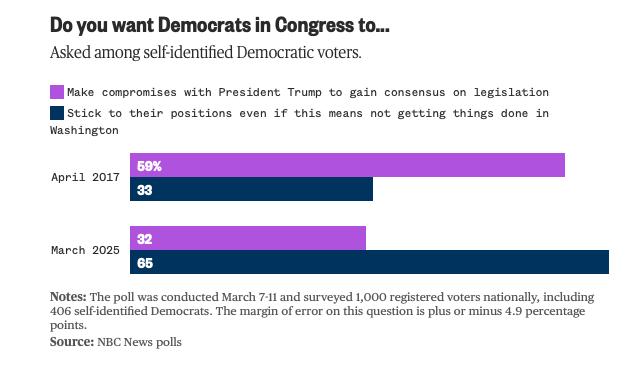
The Leadership Vacuum and Uncertain Future
Despite the mounting criticism of Schumer, there is no clear consensus on who should replace him. The party’s leadership bench consists largely of veteran figures who, like Schumer, are perceived by some as too cautious or unwilling to embrace a more confrontational strategy against Trump. Senator Raphael Warnock has suggested that “new leadership” may emerge in 2026 or 2028, but there is no immediate alternative who commands broad party support.
The Democratic Party’s leadership crisis is further complicated by a lack of consensus on who embodies its core values and should guide it into the future. A recent CNN poll underscores this uncertainty, with no single figure commanding overwhelming support; Representative Alexandria Ocasio-Cortez led with just 10%, followed closely by Vice President Kamala Harris (9%) and Senator Bernie Sanders (8%). Other prominent figures, including House Minority Leader Hakeem Jeffries, former President Barack Obama, and Governor Gavin Newsom, received single-digit support, while a significant 26% of respondents had no opinion. This fragmentation highlights the party’s identity struggle, as it seeks a leader who can unify its factions and effectively challenge Republican dominance. The absence of a clear frontrunner suggests that Democrats face an ongoing battle to define their future direction and leadership.
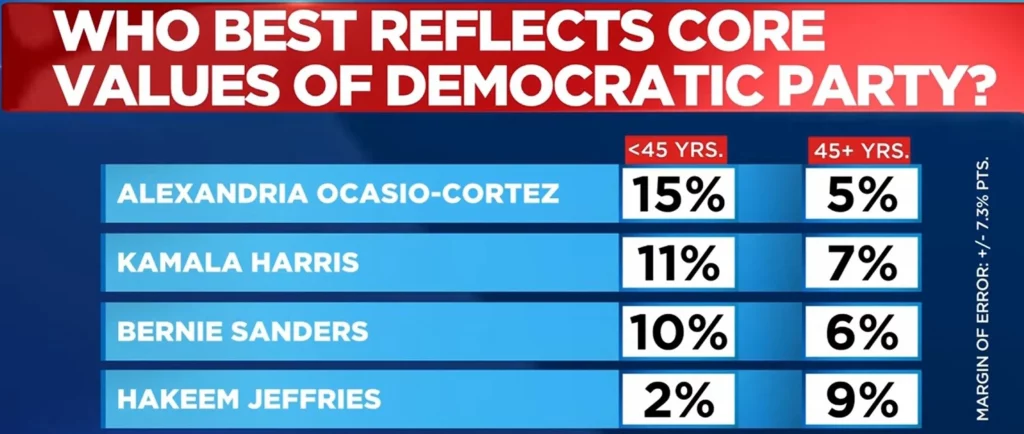
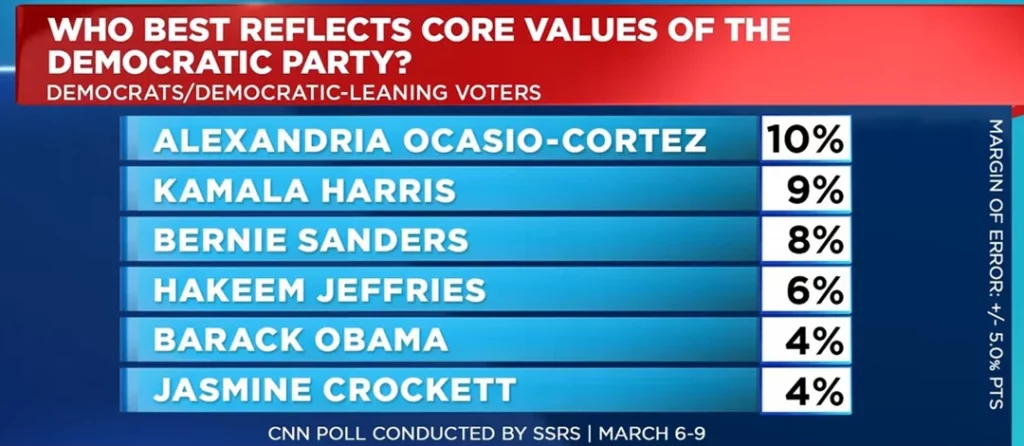
Analysis
The leadership crisis within the Democratic Party is a reflection of deeper ideological and strategic tensions that have been building for years. Schumer’s decision on the funding bill has become a flashpoint for this frustration, highlighting broader dissatisfaction with the party’s direction. With record-low favourability ratings and growing calls for new leadership, the party must now decide how it wants to position itself for the battles ahead. Whether it chooses to embrace a more confrontational approach or continues attempting bipartisan engagement, one thing is clear: the Democratic Party cannot afford to remain divided if it hopes to counter the Republican agenda effectively and regain public confidence.
While the Democratic Party is currently struggling with its identity and leadership, the broader electoral implications remain uncertain. Polling suggests that despite their internal discontent, Democratic voters are still motivated to counter Trump’s influence. The 2026 midterm elections will be a key test of whether the party can harness this energy effectively, or whether disillusionment will dampen voter enthusiasm.
